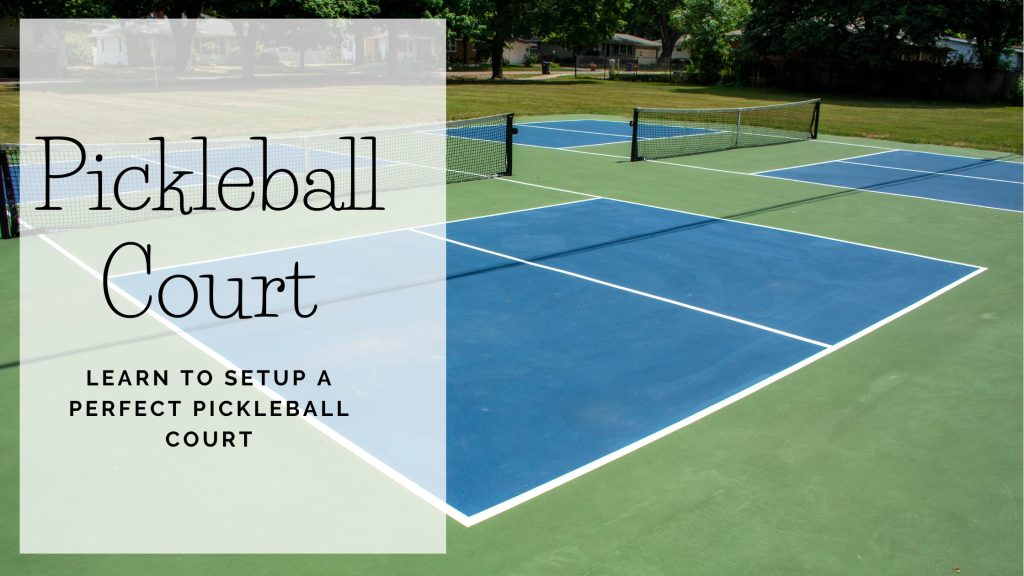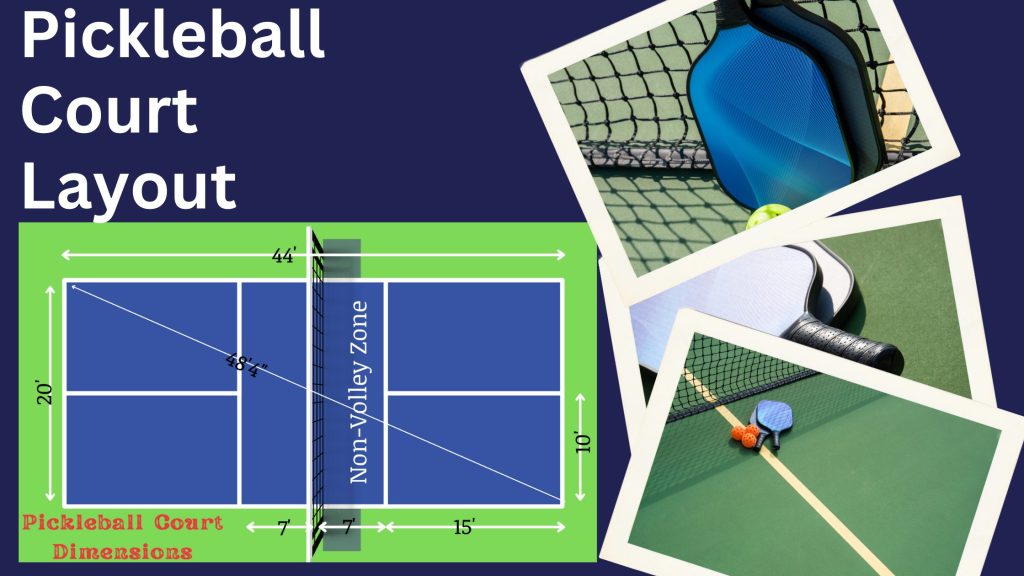If you’re like most people, the thought of playing pickleball at home always seems daunting. And if you’re not sure how to get started, fear not! A few tips will help make your experience as easy and fun as possible. By following these simple steps, you can set up a pickleball court that is perfect for your home and stay in control of the game all along the way!
What is a perfect Pickleball Court layout?

Whether you’re playing at the park or in your backyard, a perfect pickleball court layout is key to an enjoyable game. Here are a few things that need s to be kept in mind when setting up your court:
- The court should measure 20 feet in width and 44 feet in length. The service line should be 7 feet from the back wall, and the non-volley zone line should be 15 feet from the back wall.
- The net’s height should be 36 inches in the middle and 42 inches at the posts. The posts should be placed so that they are 3 feet from each side of the court.
- When setting up your pickleball court, give yourself plenty of space to play. A perfect pickleball court layout will ensure hours of fun!

Things Need To Be Considered Before Setting Up The Court
Setting up a court requires careful consideration of several factors. From legal and procedural matters to the physical layout and equipment needed, creating a court is a complex process that requires thoughtful planning. This blog will discuss the various elements that must be considered when constructing a court, from the size and type of court to the court’s rules and regulations. By taking the time to examine all aspects of the court’s design, players and officials alike will be able to enjoy a safe and enjoyable experience.
Space Required For A Pickleball Court
The rules governing pickleball in the USA are very different than those in Europe, so you may have to adjust to a smaller playing area when you’re playing pickleball here in the USA. It’s recommended to have a field that’s 34’X64′ in size, but 30’X60′ is acceptable too. Pickleball is a fast-paced game. This means that the players will have to be quick on their feet. This is one of the reasons why the courts should be small.
To reduce the sun’s glare in the players’ eyes, preserving a north-south direction is suggested when feasible. This point is important to be considered because the sun can be a significant distraction for players on the field, especially during play.
Base required for a pickleball court
Both Asphalt and Concrete are the appropriate foundation for pickleball courts. Prior to having the base installed, be sure to inspect the surfacing requirements, as there are prescribed standards regarding gradient, drainage, surface finish, and general construction.
If you choose to install a concrete base, be sure to have a professional do it. The installation should be done by a company that specializes in concrete installations. However, if you don’t have a lot of money to spend on the base, you can use asphalt.
Finding Experienced Pickleball Court Contractors
Locating proficient sports contractors can be an arduous task if you lack the necessary queries. SportMaster Sport Surfaces is the official surface partner of USA Pickleball & they are able to offer free qualified pickleball contractor referrals across North America.
Color Combinations For Pickleball Court
There are many colors to choose from. You should consider choosing different colors when planning the surface for your pickleball court. There are no fixed standard colors. There is no wrong color choice when it comes to constructing a pickleball court, but here are a few considerations to bear in mind.
- The lighter the color of the surface, the less heat it will absorb from the sun, creating a cooler playing area.
- Darker hues will take in more warmth from the sun, leading to a hotter playing field. Nonetheless, it will likewise help to dissolve snow and vaporize water faster, which may be advantageous in certain locations.
- For ideal ball visibility during play, it is important to use a pickleball color that stands out from the surface color. The best way to achieve this is to find the opposite hue on a color wheel to maximize the contrast between the two colors. This way, the human eye will be able to quickly identify the pickleball when it is flying over the contrasting surface color.
- Surfaces that are reflective or that are painted white can have an effect on ball visibility. White surfaces will tend to make the ball appear larger than it actually is, and dark or blue surfaces will make it appear smaller.
Coating Pickleball Court Surface
If you want to maintain your court for many years, you should keep it protected and sealed so that it will last longer. It is advised to utilize 100% acrylic coverings in the surfacing of pickleball and athletic courts. When properly implemented, they are permeable and enable a degree of vapor diffusion, which is especially important for outdoor courts. PickleMaster, the official court surface of USA Pickleball, is composed of 100% acrylic and manufactured with a tailored combination of materials. This produces an excellent texture for secure footing, genuine pickleball bounce, and reduced wear on pickleball.
Net Selection
Typically, two net designs are used, plus a multiple of durability choices available. The first type is placed directly on the court surface, while the second allows a gap between the bottom part of the net and the floor. The first type of net design is one that has no gap between the bottom of the net and the floor. These types of nets tend to be made of polyester, which is easy to clean. The second type can come in handy when playing pickleball and rolling balls underneath the net between points.
Nets made with thicker or double-braided cloth tend to be more resistant than those created with thinner materials. If you don’t have permanent posts for your net, there are plenty of portable systems to choose from, which you can buy and install. These nets can be attached to portable or permanent stands. If you don’t have a permanent net, you can create one out of PVC pipe. PVC pipes can be bought at your local hardware store. They will come in various lengths and diameters, and you can buy them on foot.
Fencing 101
Backstops: A height of at least 10 feet is required, but higher if there are any issues with the ball straying outside the boundaries.
Sidestops : The height of the barrier should not be any less than 3 feet. The length of the barrier must remain consistent with the backstop for a space of at least 20 feet, although 30 feet is preferable.
Gates: Needs to be accessible from both sides and expansive enough to accommodate wheelchairs/maintenance machinery.
Windbreaks: Suggested to ward off the breeze from interfering with the game while providing a backdrop against which the ball can be perceived.
Lighting Requirments
Due to the brisk pace of pickleball, illumination is essential. Players must act swiftly, and having good visibility is a must for playing this game. If you want to get the best lighting possible for the court, you should try to get as much light as you can within your budget limits. Other factors to think about include:
Quality of light
Sources of light
Wiring
Indoor lighting
Difference Between Indoor and Outdoor Court Surfaces
Indoor and Outdoor pickleball courts are generally comparable in terms of an ideal flooring surface. Asphalt or concrete are regularly used as the base, and PickleMaster is great for either environment. Gymnasiums often have a wooden or rubber ground, which can be utilized as a playing field. Unfortunately, these surfaces tend to be slick and may cause the ball to bounce if it’s hit at a low speed.
Resurfacing Of Pickleball court
The act of putting a new coat on a Pickleball court is known as resurfacing. This typically involves tidying up the surface, mending any cracks and depressions in order to keep away puddles, adding a base as well as color coating, and delineating the playing lines. The goal of this process is to restore the look and feel of the court. The covering system also assists in sealing and shielding the asphalt or concrete base and prolonging the useful life of the pavement.
Pickleball Court Accessories & Amenities
When it comes to building a new pickleball court, there are a few things that you’ll need to consider. As with many sports, the equipment used in pickleball can vary greatly. There are some standard things that you’ll need, but there are also a number of options available to you. Here is the list:
FAQs
Final Verdict
We hope that this article has helped you to get a better understanding of how to set up a perfect pickleball court layout. You need to start with the basic design elements. The next step is to decide on the court size. Next, you’ll need to determine the dimensions of the court. The last thing you’ll need to do is make sure that the court is well-lit. This will also help you to make an informed decision on whether or not to buy a pickleball court layout or hire a professional to do it for you.
